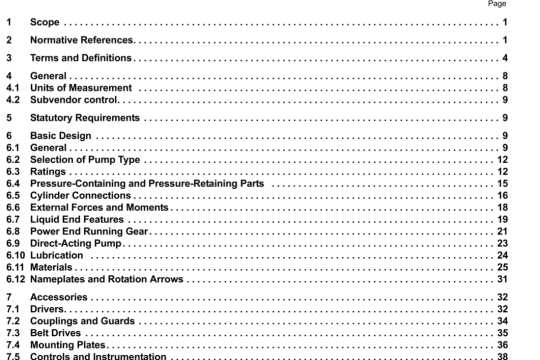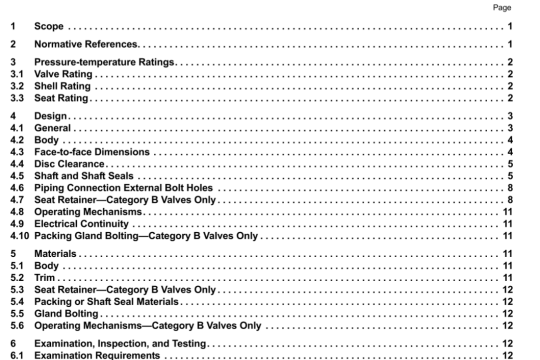API Publ 2026:1998(2006) pdf download
API Publ 2026:1998(2006) pdf download.Safe Access/Egress Involving Floating Roofs of Storage Tanks in Petroleum Service.
5.1.1 The oxygen content of the atmosphere above the floating roof may be above or below the minimum levels for safe entry. hydrocarbon vapors (for example. gasoline) may be present in the flammable range. and the arnosphere may contain toxic vapors (for example. benzene or hydrogen sulfide) that exceed established exposure limits for safe entry without respiratory equipment.
5.1.2 Before initial descent upon a floating roof is authorized, the entry supervisor shall identify the potential atmospheric hazards, determine the permit entry requireinems, and evaluate the test results.
5.1.3 A tester (who could also be the entry supervisor andi’
or an entrant) shall he designated to conduct appropriate testing for atmospheric hazards in the following sequence:
(a) oxygen. (b) flammability (combustible gases or vapors). and (c) toxic air contaminants. Initial testing of the atmosphere above the surface of internal and covered open-top floating roofs shall be conducted through the sampling and gauging hatches or other appropriate place outside the tank.
5.1.4 As a minimum, atmospheric testing shall be conducted prior to descent at the beginning of each shift, prior to reentry after any prolonged periods of inactivity or work interruption, prior to starting hot work, and any time conditions are suspected to have changed. Testing of the atmosphere in the work area above the suthice of the floating roof shall be either continuous or conducted as necessary to assure the continuation or maintenance of permitted safe working conditions. The need for continuous or intennittent monitoring and the use of approved respiratory protective equipment shall depend on the results of the testing and the potential for increased atmospheric contamination or oxygen availability during entry and work operations.
5,1.5 Should subsequent testing indicate that exposure limits or permit conditions are not being met or are exceeded, the entry supervisor shall determine whether or not work is to be continued and, if so. under what conditions and requirements. Otherwise, continued entry shall he denied, the entry supervisor or attendant shall cancel the pemiit, and work shall cease until such time as the established entry requirements are met.
5.2 POTENTIAL OXYGEN CONTENT HAZARDS
5.2.1 Atmospheric testing for oxygen levels shall be conducted before entry onto a floating roof in order to determine a) whether sufficient oxygen is present in the atmosphere to conduct Ilaritmahie vapor testing, (b) whether oxygen levels are within. above, or below the limits required to allow entry without air-supplied respiratory protection (provided that no toxic atmosphere is present). and (C) if oxygen levels are too high to either enter the confined space or to determine correct upper flammable limits and lower flammable limits of any flammable vapor which may be present.
5.2.2 The oxygen content of the atmosphere above the floating roof shall be tested to determine if it is below 19.5%. the current OSHA-esiablished minimum level ftr safe entry into a confined space without using air-supplied respiratory protection.
Note: OSIIA doe, not pcrmli entry into conhned spaces whenever the oxytcn content cxcds 215%.
5.2.3 The oxygen content of the atmosphere shall be tested to determine if it is below 10%. in which case there is not enough oxygen present to accurately determine flammable vapor levels.
5.3 POTENTIAL FLAMMABLE VAPOR HAZARDS
5.3.1 Atmospheric vapor testing shall be conducted to determine whether or not a flammable vapor air mixture is present in the atmosphere above floating roofs prior to entry. flammable or combustible liquids may be present on the floating roof, or in the pontoons. floats, or seal areas.
5.3.2 The flammable vapor or gas content of the atmosphere above the floating roof may be above 10% LFL the current OSHA-established maximum level for saf entry into a confined space. In such cases, the space above the floating roof may need to be ventilated to reduce the concentration of vapor in air or inerted to eliminate oxygen. and the atmosphere retested prior to permitting entry.
5.3.3 A flammable atmosphere may also be present inside pontoons. floats, and primary and secondary seal areas or underneath floating roofs out of flotation, These areas must be considered as separate confined spaces and must be tested appropriately, with entry restricted if the flammable vapors inside the area exceed 10% LFL. These spaces may also need to be ventilated or inerted. and the atmosphere retested. prior to penimitting entry.




